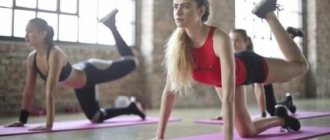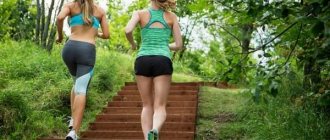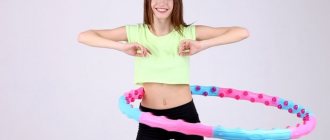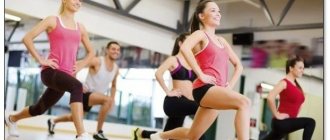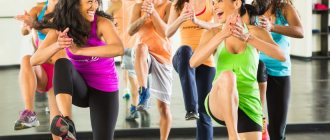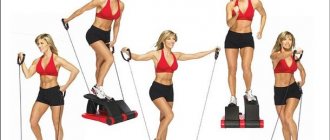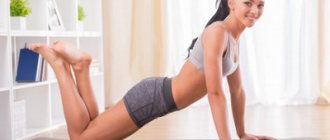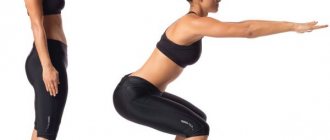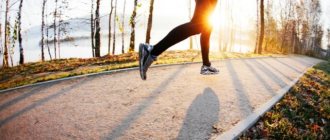Advantages, disadvantages, contraindications
Let's evaluate the benefits and harms of “home” running. First, let's look at the positive aspects of such activities:
- no sports equipment required;
- you can practice in any weather;
- saving time;
- moderate load on the knees and spine;
- lack of embarrassment in front of others;
- free class schedule.
Disadvantages of home jogging:
- low efficiency (compared to classic running on the street);
- monotony;
- lack of fresh air.
Running on the spot at home does not harm the body, but is simply less productive than street exercise. In defense of home training, we note that it has many useful properties:
- cardiovascular training;
- strengthening muscles, ligaments, tendons;
- improved digestion;
- normalization of the reproductive system;
- weight loss;
- calming the nervous system;
- getting rid of depression;
- working on women's problem areas (hips, buttocks, back of the arms).
Despite the “mild” effect on the body, running at home has some medical contraindications:
- damage to the spine or joints;
- varicose veins;
- coronary syndrome;
- late stages of pregnancy;
- recovery period after surgery.
If you have health problems, be sure to visit your doctor. Only he can decide on the use of physical activity as a preventive measure. Otherwise, you risk worsening your health and accelerating the progression of the disease.
According to statistics, Russia is in third place in the prevalence of hypertension. The disease is characterized by high blood pressure, which damages the cardiovascular system and other internal organs. As a result, the risk of developing irreversible consequences increases.
Moderate sports activity is considered one of the methods for preventing hypertension. Running in place is suitable as physical therapy. It helps to dilate blood vessels, relax muscles and normalize blood pressure.
What you need to know
Running on the spot at home can be done much more effectively if you know which muscle groups are involved during training. This will help focus the load on problem areas and speed up the process of getting rid of extra pounds.
The main work during this exercise is performed:
- calf muscles;
- quadriceps thigh muscles (quadriceps);
- gluteal muscles;
- biceps femoris muscles.
The abdominal and lumbar muscles receive additional stress.
It should be borne in mind that local fat burning does not exist and it will not be possible to remove fat only in the lower part of the body. The body will lose weight evenly.
Basic Rules
The effectiveness of running in place will increase significantly if you perform it according to certain rules.
Basic instructions:
- shoes should be comfortable. It is necessary to use sneakers with soft, springy soles;
- sportswear should cover the knee and ankle joints. This is necessary in order to minimize the risk of injury;
- exercises must be performed technically. While running, your back is straight, your abdominal muscles are tense, your arms move synchronously with your legs;
- Breathing should be controlled. The rhythm should be even, breaths should be frequent and shallow (if training is carried out on a balcony in the frosty winter, it is recommended to breathe only through the nose);
- the stomach should be empty. You should start running in place no earlier than 3-4 hours after your last food intake.
For those just starting to exercise, it is important to monitor your heart rate. Its upper limit can be calculated using the formula 220 minus its own weight. The lower threshold is determined as follows: (65 + upper value)/2. For most people, training is most effective between 120 and 140 beats per minute.
Effectiveness for weight loss
Running in place helps you lose weight due to the fact that during its execution the body expends a large amount of energy. So, in one hour of training, 300–350 kcal are consumed. For comparison: 1 hour of jogging allows you to spend approximately 400–450 kcal.
During the exercise, the production of anabolic hormones (testosterone, somatotropin) is activated, which makes it possible to speed up the process of fat breakdown.
Thanks to running, an increase in the metabolic rate in the body is achieved, which is an additional factor in rapid weight loss.
It should be borne in mind that you will not be able to get rid of extra pounds by running in place if you do not follow a low-carb diet at the same time as training. Its essence is that the basis of the menu should be proteins (lean meats and chicken, fish, eggs, cottage cheese), complex carbohydrates (cereals, durum wheat pasta) and fiber (fresh vegetables).
The effectiveness of running for weight loss will be as high as possible if the training is carried out in the morning immediately after waking up, after drinking a glass of clean water.
Contraindications
Running in place is contraindicated for diseases of the knee or ankle joints (arthritis, arthrosis). Axial load can cause increased inflammation, damage the cartilage tissue of the joint, and cause severe pain.
As a replacement for dynamic, axial loads for fat burning and improving muscle tone, it is advisable to use static exercises: chair, bridge, etc. They make it possible to create high tension in the muscles without putting stress on the joints.
People with severe pathologies of the cardiovascular system and respiratory organs should exercise with caution during the recovery period after surgery and injuries. It is recommended to consult a doctor before starting classes.
All types of physical activity must be abandoned if symptoms of infectious diseases appear: fever, cough, chills, aching joints, severe headaches, etc.
What muscles are involved?
Like classic outdoor jogging, jogging in place forces the whole body to work. The load is placed on the legs, abs, back, and shoulders.
Due to the specific technique, the emphasis falls on the lower legs (calf, soleus) and thighs (quadriceps). Thanks to this, the athlete gets the opportunity to make his legs slimmer.
Of course, we are not talking about any gain in muscle mass. Running exercises in place help correct the shape of the lower extremities, toning the muscles and reducing body fat.
Warm up before running in place
It is necessary to warm up muscles, ligaments, tendons, and joints before each workout. First, it reduces the risk of injury. Secondly, it improves the body's sensitivity to stress. We offer an example of a simple warm-up for home training:
- Squats without additional weight (15–20).
- Forward lunges (15 on each leg).
- Rotations in the knee and ankle joints (20 times each).
- Swing your arms (20 times forward and backward).
- Bend forward and to the sides (15–20).
- Jumping in place with high hips (10–12).
If you have a cardio machine at home (elliptical, stepper), replace the leg warm-up with 10 minutes of walking at a calm pace. This will be enough to warm up your whole body and prepare for the main part of the lesson.
Basic techniques
By changing your running technique in place, you can easily increase or decrease the intensity of your workout and focus the load on the desired areas of the body.
The most effective types of exercise are:
- running with high knees;
- running with the legs whipping backwards;
- mincing run.
Running in place with high knees
The exercise perfectly loads the abdominal muscles (especially in their lower part), thighs, calf muscles and back. It is recommended to use primarily for those who want to quickly get rid of folds on the stomach.
The technique requires running in place according to the rules:
- Your knees should be raised until they are parallel to the floor.
- You need to lower your foot onto your toes.
- The arms should move synchronously with the lifting of the legs.
It is most effective to perform the exercise in cycles - 4-6 series of 60-120 seconds each. The rest time between sets should be set based on heart rate values - you should start the next series when the number of heart contractions reaches 110–120 beats per minute.
Running in place with shin lashing
This technique should be given attention to those who want to tighten the back of the thigh (biceps muscles) and improve the shape of the buttocks.
It is advisable to perform overlapping runs in small, high-intensity series: 8–10 approaches of 30–40 seconds. The pace is as fast as possible.
It is important to ensure that your shins touch your thighs when bending your knees. The abdomen should be pulled in throughout the entire working approach.
Mincing running in place
The technique of performing the exercise is to quickly transfer body weight from one leg to the other. In this case, the sock should not come off the floor.
The main load falls on the calf muscles of the lower leg.
Mincing running is very useful for fat people and those who, due to problems with the musculoskeletal system, are not able to raise their knees high or overlap their shins. This exercise is effective to use at the very beginning of your workout, immediately after warming up.
Treadmill workout
Using the exercise machine allows you to run in place with maximum efficiency. This is due to the fact that most modern treadmills have a digital screen (mini-computer), which allows you to set the load based on the individual characteristics of a person, control the distance traveled, and monitor calorie consumption.
It is advisable to perform low-intensity training on a simulator lasting from 25 to 50–60 minutes. The intensity should be controlled based on the pulse. If necessary, it is possible to take 2-3 two-minute rest breaks during the workout.
Technique of running in place
Correct technique is the key to the effectiveness of any exercise. The same applies to running elements. To make home training productive, adhere to the following rules:
- Start by simply walking in place. There is no need to raise your knees high. The task of this stage is to smoothly enter the training regime. Continue for 2 minutes.
- Then move on to easy running in place. Keep your back straight. Try not to lower your heels to the floor, move on your toes. As you raise your hip, also lift your opposite arm, bent at the elbow.
- Relax your shoulders, don't lean forward, don't lower your head. If it works, breathe through your nose; if not, use a mixed style (inhale through your nose, exhale through your mouth).
- Some beginners make the grave mistake of sticking their toe into the floor. This harms the ankle and knee joints. Therefore, when moving, try to lower your foot gently.
- Once you have completed the main part of your workout, gradually reduce your pace until you reach a walk. “Walk” in place for a couple more minutes to calm your heart and restore your pulse.
In home training, it is not at all necessary to use equipment and, in particular, sports shoes. You can exercise barefoot or in socks. But be prepared for the fact that after class there will be pain in the toes of your feet. If this happens constantly, we recommend running in sneakers. Professional models with shock-absorbing soles are best suited.
Basic types of walking and running
Elena Karagaeva
Basic types of walking and running
BASIC TYPES OF WALKING
1. Normal Technique:
The foot is placed on a support from the heel, then rolled over the foot onto the toe and goes into repulsion.
Hand position:
Free.
Simulation of movements:
For kids “Our feet are walking.”
2. On toes Technique:
The steps are short, the leg is placed on the forefoot, part of the foot (on the half toes, the heel does not touch the surface.
Hand position:
Free.
Imitation of movements:
“Giants” (tall people).
3. On the heels Technique:
The foot is placed on the heel, the toes are raised up.
At the same time, you should not turn it too far to the sides. Arm position:
Bend at the elbows and clasped behind the back.
Simulation of movements:
"Penguin"
4. With high knees . Technique:
The foot is placed on the front part, and then on the entire foot.
The leg bent at the knee rises forward and upward. The shin forms an angle with the thigh, the toe is pulled down. Arm position:
To the sides, swinging your arms.
Imitation of movements:
“Cockerel”
OR Hand position:
Hands forward, fingers clenched into a fist and in front of the knee.
Imitation of movements:
“Horses”
5. Wide stride Technique:
(in older groups) The leg is placed by rolling.
Hand position:
On the belt.
Imitation of movements:
"Gulliver"
6. In a squat Technique:
Performed with legs completely bent at the knees.
The leg is placed on the entire foot. At the same time, try to keep your back straight. Hand position: On your knees. Imitation of movements:
“Geese”
7. In a half squat Technique:
On half-bent legs. The leg is placed on the forefoot. Performed on half-bent legs. Try to keep your back straight.
Hand position:
Elbows bent, fingers spread wide.
Imitation of movements
"Duckling"
8. With a cross step Technique:
One leg is brought forward. Placed in front of the other one a little to the side. Little progress has been made.
We place our legs on the entire foot. Hand position:
On the belt.
Imitation of movements:
“Rope”
9. Back forward Technique:
One leg is placed back on the forefoot or the entire foot.
Look over your shoulder. Hand position:
Behind the back.
Imitation of movements
: “Cancer”
10. Extension step Technique:
The step begins with either leg.
At the same time, one leg is brought forward, the other is placed next to it. Both legs end up together, their heels connected at each step. Hand position:
Various hand positions (behind the back, on the belt).
Imitation of movements:
“Centipede”
11. Lunges Technique:
The leg brought forward is placed with the knee bent over the entire foot.
The remaining leg behind stands on its toe. The push is made with the toe of the standing leg. Hand position:
On the knee (raise the leg, move the hands to the other knee).
Imitation of movements:
"Strongmen"
12. Sports technique:
The foot is planted from the toe with a wider step.
The foot is fully supported. Arm position:
Swing your arms back and forth. Arms are half bent.
Imitation of movements:
"Athletes"
MAIN TYPES OF RUNNING
1. Normal Technique:
Running is free, easy with natural progress on the toes.
The body is slightly tilted forward. The chest and shoulders are turned out. Half bent at the elbows. Hand position:
When moving, the arms move forward and up, slightly inward, then are pulled back to the sides by the elbows.
Imitation of movements:
With animals “Deer”, etc.
2. On toes Technique:
Feet should be placed on the front of the foot, without the heel touching the floor.
The step is wide. The pace is fast. Hand position:
Hand movement is free, relaxed in time with the step.
Imitation of movements:
“Mouse”
3. With high
raising the knees Technique:
Raise the leg bent at the knee at a right angle.
Place it with a soft, elastic and at the same time quite energetic movement on the forefoot. Hand position:
Can be placed on the belt.
Imitation of movements:
“Horses”
4. Retracted
leg bent at the knee Technique:
The body is tilted forward.
The leg bent at the knee is pulled back after the push (try to reach the buttocks with the heel or put your hands up to your hands). Hand position:
Either on the belt or on the fifth point.
Imitation of movements:
We explain the movements here.
5. Jumping technique:
Done energetically.
With a wide sweeping movement. Hand position:
The push is done back and forth.
Simulation of movements:
"Hares", "Grasshoppers"
6. At a fast pace Technique:
Performed on the forefoot or on the toes.
The step is swift and wide. The body is tilted forward in the direction of movement. Arm position:
Active, in time with the running step, bent at the elbows.
Simulation of movements:
—
7. Slow Technique: Maintain a slow pace (do not speed up or slow down). The steps are short. The leg is placed on the forefoot bent. Hand position: Calm, arms bent at the elbows. Imitation of movements: -
8. Shuttle Technique:
A wide, rapid step alternates with sharp braking at the end.
When driving in a straight line and taking frequent steps when turning. Hand position:
Natural, assisting movement.
Imitation of movements:
-
How to reduce running noise
Neighbors sensitive to any noise can interrupt your running workout. To prevent this from happening, follow these recommendations:
- wear shoes with soft soles;
- Land exclusively on your toes, leaving your heels elevated;
- use a special non-slip fitness mat;
- work out during the day.
Don't forget, making noise in the evening is prohibited. Each region has its own legislative rules for maintaining silence. For example, in Moscow it is prohibited on weekdays to interfere with the rest of neighbors from 23:00 to 07:00, and in St. Petersburg - from 22:00 to 08:00.
How to diversify running in place
Music is a runner's faithful companion. To make your workout more enjoyable, play your favorite tracks. It is advisable that the songs match the rhythm of the lesson. This will make physical activity much easier to bear.
If music doesn't stimulate you to move, you can turn on the TV. Please note that it is not advisable to view intellectual programs during class. The brain will try to simultaneously grasp the meaning of the information and maintain the pace, which can negatively affect the training.
If you want to add some variety to your monotonous running, periodically speed up for 10–15 seconds. This way you will improve the development of the muscles of the lower body. You can add jumps - pushing off with one leg while simultaneously lifting the opposite knee.
For experienced athletes, we recommend making exercise more difficult with weights. Take light dumbbells or put sand weights on your wrists and shins. Additional exercise will help increase calorie consumption and lose weight.
Running in place and burning fat
Any intense exercise speeds up metabolic processes and burns calories. Therefore, running in place is effective for losing weight.
The rapid reduction in body fat when running is associated with the expenditure of calories. Jogging on the spot allows you to burn about 250–300 kcal per hour of continuous training. For comparison, classic jogging helps you burn an average of 500 kcal per hour. But those who study at home should not be upset. To increase energy expenditure, use soft weights or add special exercises to your workout (more on them later).
A few words need to be said about the duration of running sessions. For beginner athletes, we recommend training no more than 15–20 minutes in the first month. This is necessary for the muscles to gradually adapt to the load. After week 4, gradually increase the training time to 30 minutes.
Experienced athletes should run for at least 40 minutes. This is due to the fact that first the body burns glycogen reserves (the main source of energy for muscles) and only then begins to consume subcutaneous fat. Glycogen lasts for half an hour. Therefore, weight loss training should last 40–45 minutes.
The number of classes is determined individually. Start with three workouts per week. If you don't feel tired on rest days, add another workout. The main thing is not to overdo it. Otherwise, you can reach a state of overtraining, which will negatively affect the results of your runs.
Weight loss processes start only with a calorie deficit. Actually, running in place is needed to create a negative energy balance (when an athlete spends more energy than he receives from food). But physical activity alone is not enough. It is necessary to review the diet and avoid foods with a high glycemic index (baked goods, sugar, confectionery). The combination of a low-calorie diet and regular running exercises will quickly get rid of extra pounds.
How does the training work?
SBU can be performed both as a warm-up before running, and as part of the exercise itself. Do them often, following the technique carefully. The distance and number of approaches depend on the level of training. Do not rush to do the first SBU program right away; if you are a beginner, even the first correct exercise will be enough.
So, let’s analyze a set of special running exercises for athletes and runners.
Jumping from foot to foot with circular movements of the arms.
The exercise prepares the leg for running, increases the force of repulsion from the surface and improves coordination.
In the first option:
- the upper shoulder strap is not clamped, the arms are relaxed, work from the legs,
- We jump on one leg, then on the other.
In the second option:
- do the same, but add some manual work,
- In addition to training the leg muscles, we develop the muscles of the shoulder joint and back.
Running with shin sprains
Many people remember this exercise from physical education lessons. The idea is to touch the buttocks with a high cadence and a slight forward movement. The arms can either move or be closed at the back.
Common mistakes: anchoring the entire foot, moving quickly (the goal is to do as many sets as possible, not to run the distance as quickly as possible), clasping your hands (without pressing them very close to your body), holding your breath and small amplitude (it’s better to do fewer repetitions, but correctly).
Running with your knees high
- This is a common exercise in which you push your leg from a high support and raise your knee as high as possible.
- Your arms should be bent at the elbows, your back should be straight, and your shoulders should be free and relaxed.
- At first, the hands can help, but at higher levels, they should be near the body or behind the back.
- It is very important that your feet rest only on the toe, and not on the entire surface of the foot.
These exercises are great for exercising your abdominal muscles and developing your heart. Also, these exercises perfectly warm up the body and burn excess fat in the body. It is not recommended to use them intensively for people with knee problems, a diseased or weak heart, or obese people.
Heel-to-toe rolls
This exercise is performed while standing still.
- You need to place your feet at a distance of 15 centimeters from each other.
- Starting position on your toes, after which you exhale - you need to roll over onto your heels and back.
- Usually for an untrained person this is 20-30 times in several approaches.
- Arms and shoulders should be in a relaxed position, with a straight back.
- It should be performed carefully to avoid any discomfort.
These exercises are for correct foot position while running and are also useful for flat feet or varicose veins.
Deer running
- Multi-jump, also known as deer running, is used not only in professional sports, but also in the general training program.
- This exercise improves speed and strength when running and develops correct posture during push-off.
- The position of the body in this exercise should be constantly level, active work of the arms, pushing off with the legs, makes it possible to assume the position of a straight line, and the front part bends at the knee and goes forward and slightly up.
Running on straight legs
- You need to take a standing position and extend one leg so that it is completely straight.
- From this point on, running begins, both legs should be equal throughout the entire exercise.
- The arms are bent at the elbows and are at the level of the abs, stretching your back to your legs.
- We stand on our toes, not on our entire leg.
These movements warm the body and work the calf and gluteal muscles.
Running backwards
This type of running is used to improve emotional balance and coordination. In addition, this exercise trains muscles that are difficult to strengthen during daily running.
Positively affects and strengthens the musculoskeletal system. It's like running with a straight leg only in motion.
Cross-step running
Cross running strengthens muscles and increases speed by coordinating movements:
- First you need to stand straight, with your feet at a distance of 5-10 centimeters from each other.
- Then you need to take a side step so that one leg goes behind the other and the other goes back.
- Arm movements alternate to maintain the body's center of gravity.
Bicycle or wheel running
Based on the name, you can guess that this type of running is similar to cycling. The main goal of this exercise is to create a strong impulse, lifting the leg and knee up and forward and making circular (shaking movements) rotations of the leg to the starting position.
Since this exercise is performed in motion, you need to move your arms vigorously, as if you were running. Such movements perfectly develop the heart and the main muscle groups of the legs.
To improve your performance in athletics, it is recommended not only to perform basic exercises once a day, but also to focus on complex exercises.
Running exercises
Let's consider exercise options that can be used to increase the load and fully work out the muscles of the lower extremities:
- Running with overwhelm . The athlete tries to touch the heel to the buttocks with each lift of the foot. The exercise stretches the quadriceps well and effectively loads the hamstrings.
- Running with high knees . When performing, the hips rise to parallel with the floor or higher. Exercise helps increase the number of calories burned and increases the stress on your hips.
- With arms waving . The athlete performs a simple run in place and simultaneously rotates his arms forward. The element additionally strengthens deltoids and accelerates weight loss.
- Running in place while lying down . Exercise helps diversify your workout. In addition, when performing, not only the muscles of the legs are worked out, but also the arms and abs.
- Running onto the platform . The exercise uses a step platform. The athlete moves energetically, moving his feet from the floor to the stand and back. The element accelerates the burning of calories.
- Lateral movements with jogging . The athlete takes quick short steps in place, sharply shifts to the side a meter and again takes 3-4 running steps. Then he repeats it back. The exercise allows you to develop agility, mobility, and speed.
A set of running exercises, educational and methodological material on physical education on the topic
Running complex
athletics exercises.
Compiled by:
Domracheva Elena Nikolaevna
physical education teacher
MBOU "Secondary School No. 2" Usinsk, Republic of Kazakhstan
To master the rational technique of performing one or another type of athletics, special athletics exercises (SBU) are of great importance, on the one hand, developing the basic physical qualities of an athlete: speed, speed and speed-strength endurance, strength, and on the other hand, similar in structure with the technique of performing the main exercise.
Special exercises that primarily develop speed should consist of movements close to the elements of running technique. These exercises should be performed in conditions that allow the movements to be performed as quickly as possible. Exercises that primarily develop speed should be short-term and performed repeatedly, on the spot or in motion. Exercises in this category include the following:
- Running with shin splints
The trick of the exercise is to touch the gluteal muscles with the heel, while there should be a maximum step frequency and a slight movement forward. Can be performed with the movement of the arms or with the arms behind the back.
- Running with high hips
When pushing off with your supporting leg, you need to raise the thigh of your swing leg high. As with the previous exercise, you need to maintain a high frequency of leg lifts.
While performing this exercise, your shoulders should be relaxed, your arms bent at the elbows, your supporting leg and torso should be on the same line. The foot lands on the front part, the back should be straight. Beginners can work with their hands, experienced runners can isolate their hands behind their backs.
- Running on straight legs
The main thing in this exercise is to have straight legs and land on the forefoot. You need to quickly move forward (this is still running, not walking) and a slight tilt of the torso back.
- Deer running
Basically, it's a hellish mixture of jumping and running. It will be difficult for beginners to master it. I recommend imagining an obstacle in front of you, for example a log, over which you need to jump with one leg, while bending the knee. The second leg is always straight.
- "Bike"
The movement is reminiscent of pedaling a bicycle while moving forward. When pushing off with the supporting leg, you need to move the thigh of the swing leg forward, followed by a “raking” movement of it down and back.
You should pay attention to the fact that the “raking” movement of the foot down should be fast.
- Lunges
Maximum wide steps, placing the foot on the heel, deep squatting. If done correctly, over the next two days all the leg muscles will remind themselves of themselves in the most unexpected places.
- Mincing run
Short steps as long as your own foot. Land on your toes, relaxed shoulder girdle and arms. When running, you can imagine yourself as sour cream, which is poured into a jar.
- Running uphill 60-100 m with and without arms
For beginners, we do not recommend starting with slides that have a large angle of inclination. The main thing in this exercise is the width of the step, not the frequency and speed. Particular attention should be paid to pushing when moving and working with your hands.
- Jumping run on one leg
Pay special attention to the pushing leg - it should be straight, while the supporting leg is bent at the knee at a right angle. Try to push as high as possible, not further. Progress forward is minimal.
- Running while jumping on one leg but landing on two legs
The only difference with the previous exercise is that you need to land not on the pushing leg, but on both.
- Jumping on straight legs
The push here is performed only with the foot. Make sure that the leg does not bend at the knee (this is the main condition). Try to jump as high as possible.
- Multi-jumps
Comment: Like the run-in step, we do multi-jumps with a short run-up. The exercise is difficult, but if you do it technically, the feeling of “getting into yourself” will be very clear, and this will help maintain the feeling of flight with minimal effort. We carefully monitor the correct work of our hands! We don’t lean forward in an effort to increase speed. And let’s not rush - let yourself hang in the air, as if in a running step.
Running in place and jumping
In addition to the elements discussed above, we recommend adding plyometric loads to your running training. For example, jumping rope can replace a warm-up or increase calorie expenditure by doing two 10-minute approaches before and after running. By the way, when using a jump rope, an athlete spends the same amount of calories as during classic jogging (about 500 kcal/hour).
Jumping elements can also be included in the lesson itself. We have already said that jumping helps to diversify the monotonous rhythm of training. In addition, using plyometric exercises, the athlete improves the development of the lower body. For example, jumping out of a lunge with a split leg loads not only the large muscles of the legs, but also the small muscles responsible for stabilization.
Which is better: running in place or treadmill?
A treadmill is definitely better, as it has many advantages:
- When moving on the simulator, the athlete takes full running steps, which increases the beneficial effect on the body.
- The track has the option of changing the load, which is necessary for gradual progression.
- The cardio machine is equipped with additional functions that allow you to monitor the results and condition of the athlete: measuring the distance traveled, calories burned, pulse, etc.
- A variety of exercises are performed on the electronic track that work the leg muscles well.
- Variable load and the ability to run fully contribute to the rapid loss of excess weight.
Yes, the electronic track is an expensive projectile. If purchasing such a machine is not practical, then running in place will help reduce body fat and improve the appearance of your legs. Although this will take more time.
How to start training
The lesson should be structured in such a way that the training is as effective as possible and does not cause harm to health.
The training cycle should consist of 3 stages:
- Warm up. It is necessary to warm up the ligaments, joints and muscles, saturate cells and tissues with oxygen, and prepare the cardiovascular system for the main load. Simple exercises are suitable for warming up: bending the body forward, backward and to the sides, swinging your arms clockwise and back, lifting your legs forward and backward. Duration: 7–10 minutes.
- Basic training. It is recommended to perform the main phase of the lesson using several techniques (with overlapping of the shins, with raising the knees, mincing running). Training time should be distributed evenly between each type of load. The duration of the main workout should be in the range from 25 to 60 minutes (depending on the level of athletic readiness of the person and his state of health).
- Hitch. Necessary in order to smoothly return to normal heart rate and restore breathing. During the cool-down, it is recommended to walk around the room, taking deep breaths, and stretch your ligaments.
Training program
A training plan must be drawn up individually for yourself, based on criteria such as body weight, age, lifestyle, presence of diseases, etc. To select the optimal training regimen, it is recommended to contact a fitness trainer.
Table: approximate program for 7 days
| Day of the week | Exercises | Duration of training |
| Monday | mincing running in place + running in place with shin overlapping | 35–40 minutes |
| Wednesday | mincing running in place + running in place with high knees | 40–45 minutes |
| Friday | exercise on a treadmill | 55–60 minutes |
If jogging on the spot is performed at a high pace and the duration of the workout exceeds 45–50 minutes, you should refrain from daily exercise. Muscles need time to replenish energy reserves and repair damaged muscle cells. In order to avoid overwork, it is recommended to exercise no more than 4 times a week.
Running in place at home is an effective way to lose weight and keep yourself in good shape. However, this type of load primarily involves the muscles in the lower part of the body, without creating the proper tension in the upper body. To develop all muscle groups, it is recommended to add exercises for the chest, shoulders and back to your workouts: pull-ups on the bar, push-ups, dumbbell raises to the sides.
